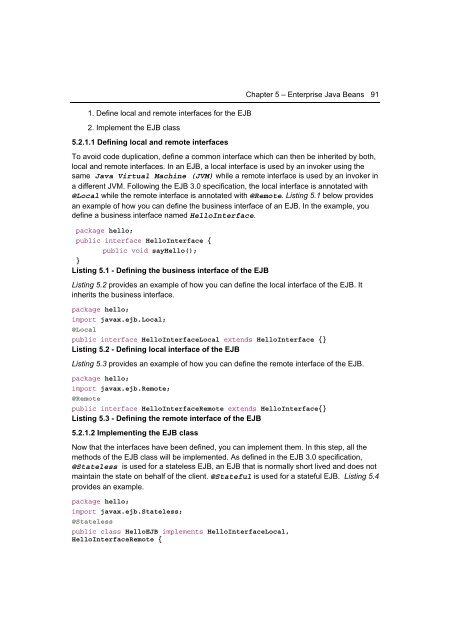Getting Started with WebSphere Application Server
Create successful ePaper yourself
Turn your PDF publications into a flip-book with our unique Google optimized e-Paper software.
1. Define local and remote interfaces for the EJB<br />
2. Implement the EJB class<br />
5.2.1.1 Defining local and remote interfaces<br />
Chapter 5 – Enterprise Java Beans 91<br />
To avoid code duplication, define a common interface which can then be inherited by both,<br />
local and remote interfaces. In an EJB, a local interface is used by an invoker using the<br />
same Java Virtual Machine (JVM) while a remote interface is used by an invoker in<br />
a different JVM. Following the EJB 3.0 specification, the local interface is annotated <strong>with</strong><br />
@Local while the remote interface is annotated <strong>with</strong> @Remote. Listing 5.1 below provides<br />
an example of how you can define the business interface of an EJB. In the example, you<br />
define a business interface named HelloInterface.<br />
package hello;<br />
public interface HelloInterface {<br />
public void sayHello();<br />
}<br />
Listing 5.1 - Defining the business interface of the EJB<br />
Listing 5.2 provides an example of how you can define the local interface of the EJB. It<br />
inherits the business interface.<br />
package hello;<br />
import javax.ejb.Local;<br />
@Local<br />
public interface HelloInterfaceLocal extends HelloInterface {}<br />
Listing 5.2 - Defining local interface of the EJB<br />
Listing 5.3 provides an example of how you can define the remote interface of the EJB.<br />
package hello;<br />
import javax.ejb.Remote;<br />
@Remote<br />
public interface HelloInterfaceRemote extends HelloInterface{}<br />
Listing 5.3 - Defining the remote interface of the EJB<br />
5.2.1.2 Implementing the EJB class<br />
Now that the interfaces have been defined, you can implement them. In this step, all the<br />
methods of the EJB class will be implemented. As defined in the EJB 3.0 specification,<br />
@Stateless is used for a stateless EJB, an EJB that is normally short lived and does not<br />
maintain the state on behalf of the client. @Stateful is used for a stateful EJB. Listing 5.4<br />
provides an example.<br />
package hello;<br />
import javax.ejb.Stateless;<br />
@Stateless<br />
public class HelloEJB implements HelloInterfaceLocal,<br />
HelloInterfaceRemote {

















